Beekeepers love their little six-legged girls almost as much as most people love their cats or dogs.
Bees make excellent pets because, most of the time, they don’t need us. They walk themselves, self-medicate, and handle their own nutrition. If honeybees were slightly more cuddly, they’d edge out puppies as a favorite.
Even though honey bees handle their own food, we humans have altered the environment so much that they no longer have the rich diet they are used to.
We replaced natural weeds and other plants in every home, like dandelions and cloves, with carpet-like lawns. They’re beautiful but offer nothing for a honey bee.
In a perfect world, we wouldn’t worry about what honey bees eat, but we take away their food source. So now, we need to know what honey bees eat and how to put it back.
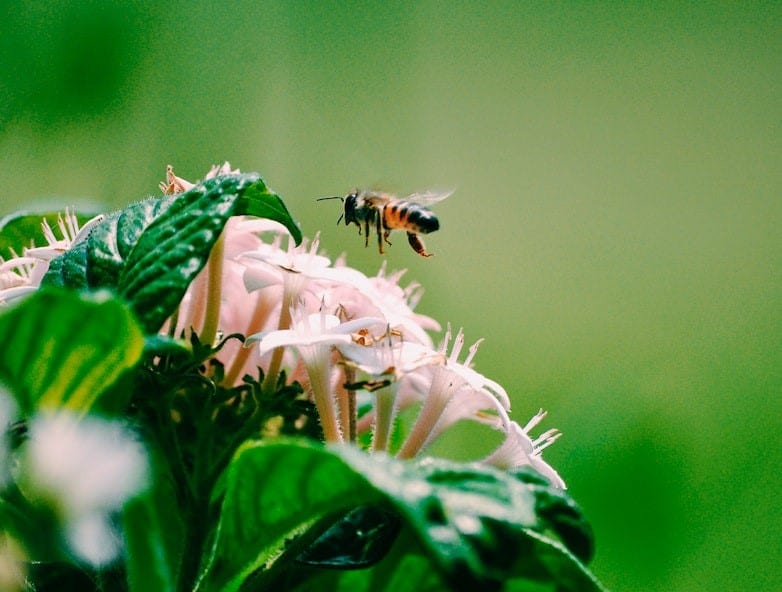
What Do Bees Eat?
Honey bees ingest nectar, pollen, and water. We’ll take a closer look at their dietary needs by asking two questions.
What do they eat for energy?
We get our energy from carbohydrates, which are broken down into simple sugars. In the bee world, nectar is the main source of energy.
Nectar from flowers, the main ingredient in honey, is full of sugars. It also contains minerals, amino acids, and a bunch of other stuff in small quantities.
Nectar is the reward plants use to incentivize bees and other insects to act as couriers. These pollinators deliver vital genetic material from one flower to another.
Since bees aren’t the only pollinators out there, different plants and flowers can go with different methods to attract their chosen pollinator, as not all flowers have nectar.
Honey bees are quite resourceful, even in the absence of nectar. They look for aphids. As aphids eat, they secrete a liquid, which is basically sugar water. This liquid is slightly digested, but it is mostly sap. This is known as honeydew.
Ants have been known to “farm” aphids for this precious product. Bees don’t share those animal husbandry skills, but they take advantage of honeydew and turn that into honey. The resulting flavor of the honey isn’t very sweet, but it’ll get the bee colony through their dearth.
What they eat for everything else (protein, vitamins, minerals, lipids)
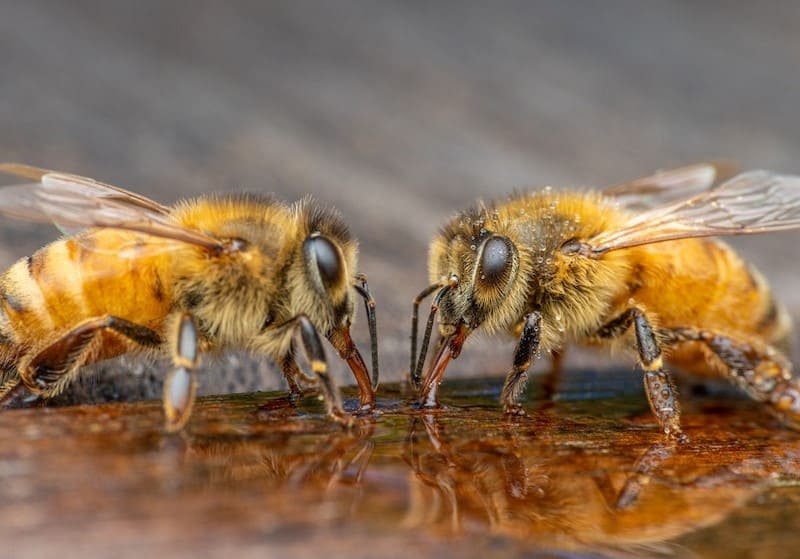
Even though bees are vital to plant procreation, pollination is purely accidental. They actually want the pollen for themselves.
Protein is needed most by brood. Growing bodies, or in this case, metamorphosizing bodies, need bodybuilding food. When eggs first hatch, these bees eat royal jelly, their first food.
A few days later, the menu expands, and they are fed on a mixture of royal jelly, pollen, and honey.
Royal jelly is secreted by young adult bees called nurse bees. These bees are the equivalent of teenagers. They stay indoors, babysit and eat everything in the house. They are the only adult bees that eat pollen. Unlike teenagers, they clean up after themselves.
Who Eats What
Generally, flowers and plants are the primary food and water sources for bees. Bees gather nectar and pollen from these flowers to feed themselves and their larvae back in the hive.
But different bees eat different things.
The Queen Bees’ Diet
The queens feed solely on royal jelly. Since their lifespan is 28 times longer than their average offspring, people automatically assume that royal jelly is the real fountain of youth.
As it turns out, that’s not exactly true. It’s what this bee doesn’t eat that keeps her productive, specifically pollen and nectar. A queen bee doesn’t eat honey, either.
To make food fitting for queen bees, nurse bees must consume bee bread, which is a mix of pollen, honey, and bee saliva. In that way, honey and pollen are vital to her sustenance but consumed indirectly.
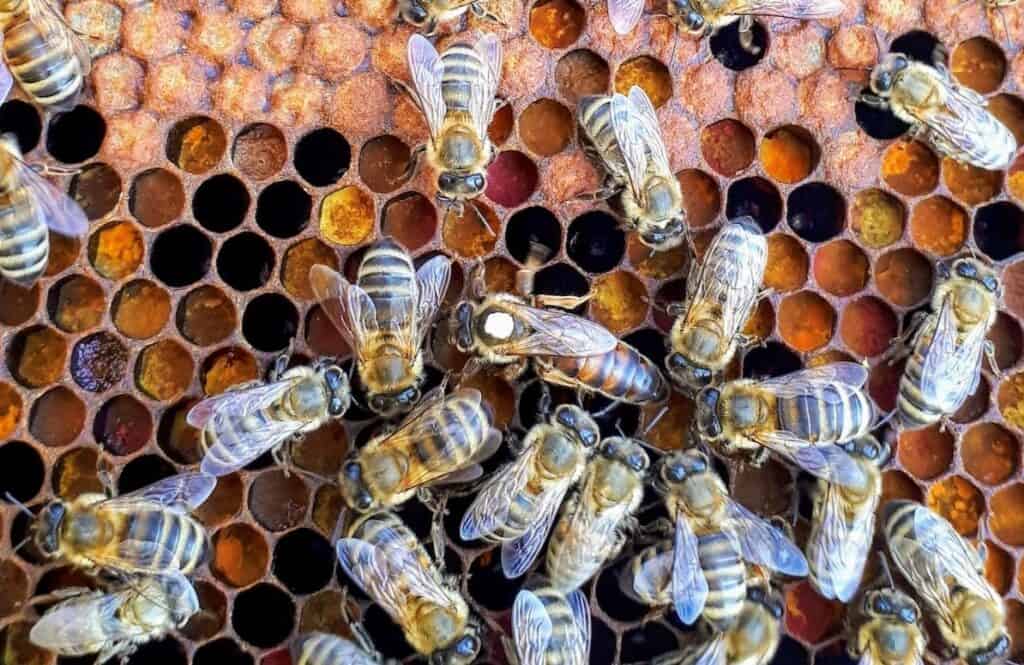
Brood
The first three days after brood hatches, all these bees eat is royal jelly. That is why queen breeders need to identify honey bee larvae that are the right age when they are looking to make honey bee queens.
If they pick the larvae too late, once it is being fed on pollen, no queen can be made.
After the third day, worker brood is introduced to the pollen mixture, and they maintain that diet until they become foragers in the bee colony.
Worker bees
Worker bees have different job descriptions. You have the young nurses, which is the entry-level job in the honey bee colonies. They are the ones that take care of the queen and the young, so these bees eat both pollen and honey. Once they graduate into foragers, they are only interested in nectar and honey.
That’s why worker bees store so much honey when preparing for the winter. Since there is little to no brood, they don’t need to stock up on both pollen and nectar.
In fact, the presence of nectar and pollen tells the bee colonies that the queen bee can start laying once more.

Drones
Drones have no brood-rearing requirements, so they only get pollen grains before they emerge as adults. They consume honey but not for very long.
They live to mate with the queens. And once they do, they drop right out of the sky, probably with a smile on their faces.
Before they get lucky, however, they stroll into any hive for dinner. That’s why, during a nectar dearth, the drones are often chased out of a hive.
When you don’t bring home the bacon, you don’t get a seat at the table when times get hard.
When Nature Fails, Supplements
Sometimes, the bees don’t have enough food. That can happen naturally, like in times of drought or a cold snap, or humans can create a shortage of their food supply by harvesting too much.
No matter the reason, we don’t just shrug and watch our colonies die. We feed our honey bees with supplements. But what is the best thing to feed bees?
Sugar Syrup
Sugar syrup (or sugar water) is often used just before spring when the winter stores are depleted or in the fall. Spring syrup is more watery, the ratio being 1 part sugar to 1 part water. This is done when the weather is warm because the bees won’t touch it if it freezes.
In the fall, beekeepers make the syrup a little thicker, having two parts sugar and one part water. That’s because the bees will still need to dehydrate it to increase its shelf life. With temperatures dropping, a thicker syrup is easier to dehydrate than the formula used in the spring.
Candy Boards
During winter, when the world is frozen over, bees will not touch frozen syrup. Beekeepers have to go for solid sugar. Many either make candy boards or use fondant, which keeps the bees going in the absence of honey.
During a dearth, in the summer, for instance, it’s not rare to see bees enjoying fruit juice. They also go for hummingbird feeders. Any source of sugar is fair game to them, so don’t be surprised if one falls into your soda.
Pollen Patties
Pollen patties are also fed to bees in the absence of pollen bread. The tricky bit about providing this is that it may trigger the queen to start laying eggs, and the colony will start to grow.
If the environment isn’t ready to support the colony, you’ll need to supplement their nectar as well.
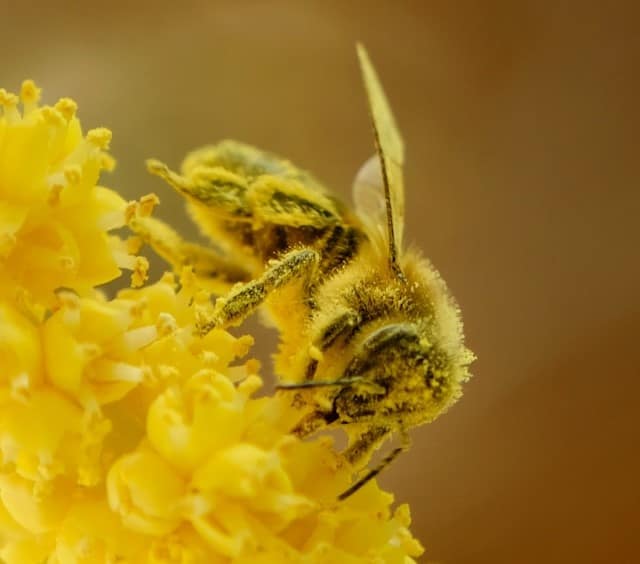
What can you do to Better the Nutrition of your Bees?
Unlike other animals, the beekeeper has little control over the nutrition of the honey bees. Unless your bees are hired as insect pollinators, you don’t really know what they’ll get their little proboscis into. Therefore, the more natural the spaces around the apiary are, the healthier your honey bees will be.
Bees need a diverse diet to thrive. We are encouraged to let the flowers, and even weeds, on our lawns grow.
A patch of clover or dandelion is a bee favorite, yet they never get to bloom because of suburban landscape regulations.
Plant trees and flowers that will provide bees with nectar and pollen. Keep pesticide use to a minimum. If you can, go organic all the time.
Sometimes, it makes sense to sacrifice a portion of the harvest to ensure that your honey bees have enough to get them through the season of scarcity. After all, they didn’t collect that nectar for you, so don’t be greedy.
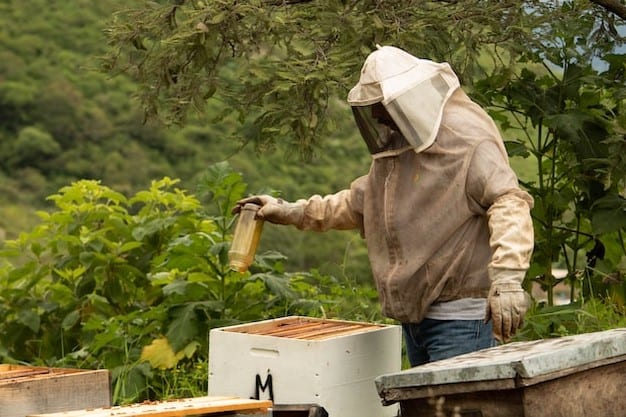
Final Thoughts
We rely on bees for pollination and bring fruits and vegetables to our tables. And they rely on us to keep their food safe. Bees have adapted to the environment by being generalists and eating whatever is available.
The least we can do is provide safe buffets in the form of pollinator gardens, plants, and fruit trees. We, in turn, feast on the delicious fruits of all their labor by biting into an apple or drizzling honey over our favorite snack.
Bees don’t need more beekeepers. Bees need more bee lovers.
